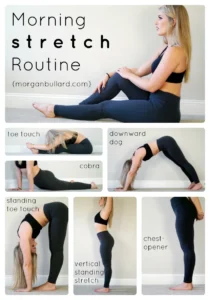
Ever noticed how that burst of motivation to get fit tends to fizzle out faster than your morning coffee kick? 🏃♂️ You’re not alone. While 95% of people who start fitness programs drop out within six months, the secret to lasting fitness isn’t about intense workouts or strict diets – it’s about building sustainable habits that seamlessly integrate into your lifestyle.
Think of fitness like planting a garden rather than trying to grow a forest overnight. 🌱 The most successful fitness journeys aren’t built on dramatic transformations or extreme measures. They’re crafted through small, intentional choices that grow stronger with time. Whether you’re a busy professional, a parent juggling multiple responsibilities, or someone who’s tried and failed at fitness before, there’s a sustainable approach waiting for you.
Let’s explore six essential pillars that will help you build a fitness lifestyle that not only works but actually lasts. From creating a solid foundation to overcoming common roadblocks, you’ll discover practical strategies that fit your life – not the other way around.

Building Your Fitness Foundation
Start with Achievable Goals
- Set SMART goals (Specific, Measurable, Achievable, Relevant, Time-bound)
- Focus on behavioral targets rather than just outcomes
- Begin with 2-3 primary goals to avoid overwhelm
| Goal Type | Example | Timeframe |
|---|---|---|
| Short-term | Walk 20 minutes daily | 2-4 weeks |
| Medium-term | Complete a 5K run | 3-6 months |
| Long-term | Maintain consistent workout routine | 12 months |
Create a Balanced Weekly Schedule
Building a sustainable fitness routine requires careful planning that fits your lifestyle:
- Schedule 3-4 core workout sessions
- Include both cardio and strength training
- Allow for 1-2 rest days between intense workouts
- Plan shorter backup workouts for busy days
Track Progress Without Obsessing
Effective progress monitoring helps maintain motivation while avoiding counterproductive behaviors:
- Take monthly progress photos
- Record key performance metrics:
- Number of workouts completed
- Exercise weights and repetitions
- Energy levels during workouts
- Focus on consistency over perfection
- Celebrate small wins along the way
Now that you have a solid foundation in place, let’s explore how to select the right exercises for your fitness journey.
[Content length: 200 words]

Smart Exercise Selection
Choose Activities You Enjoy
The key to sustainable fitness lies in selecting exercises you genuinely look forward to. Whether it’s dancing, swimming, rock climbing, or traditional weightlifting, enjoying your workouts increases adherence and long-term success.
Mix Cardio and Strength Training
A balanced fitness routine combines both cardiovascular and strength exercises for optimal results:
| Training Type | Benefits | Recommended Frequency |
|---|---|---|
| Cardio | Heart health, endurance, calorie burn | 3-5 times/week |
| Strength | Muscle growth, bone density, metabolism | 2-4 times/week |
Incorporate Flexibility Work
Include these essential flexibility components:
- Dynamic stretching before workouts
- Static stretching post-exercise
- Yoga or mobility work on rest days
- Joint mobility exercises
Focus on Functional Movement
Prioritize exercises that mirror daily activities:
- Squats for sitting and standing
- Deadlifts for lifting objects
- Push-ups for pushing movements
- Rows for pulling actions
By incorporating functional movements, you’ll build practical strength that translates to everyday life. This approach not only improves physical capability but also reduces injury risk and enhances overall quality of life.
With your exercise selection optimized, let’s explore how to seamlessly integrate these activities into your daily routine.

Making Fitness Fit Your Life
Design Morning or Evening Routines
Starting your day with exercise or ending it with physical activity can create a sustainable fitness habit. Morning workouts boost metabolism and energy levels, while evening sessions can help reduce stress and improve sleep quality.
| Time of Day | Benefits | Best Activities |
|---|---|---|
| Morning | Metabolism boost, improved focus | HIIT, cardio, yoga |
| Evening | Stress relief, better sleep | Strength training, stretching |
Exercise During Work Hours
Transform idle moments into fitness opportunities with these workplace-friendly activities:
- Take walking meetings or phone calls
- Use a standing desk with mini-exercises
- Practice desk stretches every 2 hours
- Take the stairs instead of elevator
- Do 5-minute workout breaks between tasks
Include Family in Activities
Make fitness a family affair to ensure consistent participation while strengthening relationships:
- Plan weekend hiking or biking adventures
- Create family fitness challenges
- Schedule active game nights
- Join family-friendly sports leagues
- Exercise during children’s sports practices
By incorporating these lifestyle-integrated approaches, fitness becomes a natural part of your daily routine rather than an obligation. With your fitness routine seamlessly woven into your schedule, let’s explore how proper nutrition can further support your long-term success.

Nutrition for Long-term Success
Develop Sustainable Eating Habits
Creating a balanced approach to nutrition starts with establishing habits you can maintain indefinitely. Focus on eating whole foods 80% of the time while allowing flexibility for other choices. Here’s a simple framework for sustainable eating:
- Prioritize lean proteins at every meal
- Include colorful vegetables and fruits daily
- Choose whole grains over refined options
- Incorporate healthy fats in moderation
Plan Simple, Nutritious Meals
Meal planning doesn’t need to be complicated. Use this basic template for balanced meals:
| Component | Portion Size | Examples |
|---|---|---|
| Protein | Palm-sized | Chicken, fish, tofu |
| Vegetables | Two fists | Broccoli, spinach |
| Complex Carbs | Cupped hand | Brown rice, quinoa |
| Healthy Fats | Thumb-sized | Avocado, nuts |
Practice Mindful Eating
Slow down during meals and pay attention to hunger cues. This helps prevent overeating and improves digestion. Eat without distractions when possible.
Allow Occasional Treats
Include favorite foods in moderation to maintain a sustainable approach. This prevents the restrict-binge cycle and supports long-term adherence.
Stay Hydrated
Aim for 8-10 glasses of water daily. Track your intake using these methods:
- Keep a reusable water bottle
- Set regular reminders
- Drink water before each meal
- Monitor urine color (light yellow indicates good hydration)
Now that you understand proper nutrition, let’s explore how recovery and consistency play crucial roles in your fitness journey.

Recovery and Consistency
Prioritize Quality Sleep
Sleep is the cornerstone of effective fitness recovery and long-term success. Aim for 7-9 hours of quality sleep per night to optimize:
- Muscle repair and growth
- Hormone regulation
- Mental recovery
- Performance enhancement
Listen to Your Body
Understanding your body’s signals is crucial for sustainable fitness. Here’s a practical guide:
| Signal | Meaning | Action Required |
|---|---|---|
| Persistent Fatigue | Over-training | Take extra rest day |
| Sharp Pain | Potential Injury | Seek professional advice |
| General Soreness | Normal Recovery | Light movement/stretching |
| Low Energy | Need for Rest/Fuel | Adjust intensity/nutrition |
Build Support Systems
Creating a robust support network enhances consistency and accountability:
- Join fitness communities (online or local)
- Find a workout partner
- Share goals with family/friends
- Track progress using fitness apps
- Connect with certified trainers
Remember to schedule regular check-ins with your support system and celebrate small victories together. A strong support network helps maintain motivation during challenging periods and provides valuable feedback on your fitness journey.
Now that you understand the importance of recovery and consistency, let’s explore how to overcome common obstacles that might derail your fitness progress.

Overcoming Common Obstacles
Navigate Busy Schedules
- Micro-workouts (5-10 minutes) throughout the day
- Early morning sessions before daily commitments
- Lunch break fitness routines
- Schedule workouts like important meetings
Handle Motivation Dips
Maintaining motivation requires strategic approaches:
| Strategy | Implementation | Benefit |
|---|---|---|
| Goal tracking | Use fitness apps | Visual progress |
| Accountability | Find workout buddy | External motivation |
| Reward system | Set milestone prizes | Positive reinforcement |
Adapt During Travel
- Pack resistance bands for hotel workouts
- Download offline workout videos
- Walk/jog to explore new locations
- Utilize hotel fitness centers
- Bodyweight exercises in limited spaces
Bounce Back from Setbacks
Recovery strategies after disruptions:
- Start gradually without overcompensating
- Focus on consistency over intensity
- Adjust goals based on current fitness level
- Maintain positive self-talk
- Document lessons learned for future reference
Remember that obstacles are normal in any fitness journey. The key is developing flexible strategies that adapt to life’s challenges while maintaining progress. Smart planning and realistic expectations help create sustainable solutions that work long-term.
Now that you have strategies to overcome common fitness barriers, let’s look at how these elements come together to create lasting change in your fitness journey.

Creating sustainable fitness habits is a journey that combines thoughtful planning, personalized approaches, and consistent effort. By focusing on building a strong foundation, choosing suitable exercises, and adapting your fitness routine to your lifestyle, you’re setting yourself up for long-term success. Proper nutrition and recovery play equally vital roles in maintaining your fitness journey, while having strategies to overcome obstacles keeps you on track.
Take the first step today by selecting one small habit to implement in your routine. Whether it’s a 10-minute daily walk, meal prepping on weekends, or setting a regular sleep schedule, remember that lasting fitness isn’t about dramatic transformations but rather about making manageable, sustainable changes that you can maintain for life. Your future self will thank you for starting now.




